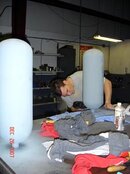Two quotes from my PSI 'manual' (Bill High's book): 'Paint, epoxy and molten zinc have been found erratically adhering to interior walls. Altered cylinders should be rejected because the possible damage may be difficult to assess.' If you put epoxy on the interior of a tank (or exterior for that matter), you may find it difficult to get a VIP done. The cylinder won't be condemned, it just won't be passed, because the inspector may not be able to adequately assess the corrosion on the surface. You may not have any problem, because inspectors have latitude - it is a judgement process in part. But, be forewarned. AND, owner painting in general is considered cause for increased suspicion during VIP. Another quote from the 'manual': 'Be warned, visual cylinder inspectors, expecially those trained at PSI Visual Cylinder Inspection Training seminars, are alert to, and most wary of, cylinders repainted by owners.' This text is in the section dealing with repainting of AL cylinders, where there may be additional issues of metal compatibility, high temperatures possibly used in repainting, etc. But, it is applicable to all cylinders, in terms of the suspicion an inspector might have. So, if you choose to have the surface refinished, have it done by a commercial shop, and make sure the condition of the surface immediately prior to application of zinc, paint, whatever is thoroughly documented. Do-it-yourself refinishing of scuba cylinders is generally not recommended.




